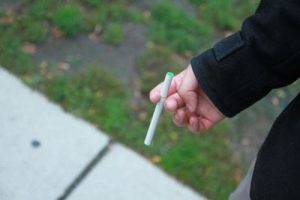FDA to Invest Over $270 Million in E-Cigarette Research
The US Food and Drug Administration seems like it’s finally getting seriously involved in e-cigarette research. Over the next few years, it will apparently be spending around $270 million on dozens of e-cigarettes studies, trying to answer several key questions, like ‘what risks do they pose to human health?’, ‘are they a gateway to smoking?’ and ‘will they reduce the number of American smokers?’
 “They want data and they want it yesterday,” Dr. Suchita Krishnan-Sarin of Yale University, who is leading four of the 48 research projects commissioned by the FDA, told Reuters. One of the team involved in the FDA-funded e-cigarette studies will be counting the puffs taken by volunteer vapers in an attempt to quantify the risk posed by electronic cigarettes. Another will keep an eye on Facebook posts relating to e-cigarettes to see how people are tinkering with their vaporizers to make them deliver more nicotine, while a third is already building a virtual convenience store aimed at 13-to-17-year-olds, to see if current marketing techniques and promotions actually influence teens into buying electronic cigarettes.
“They want data and they want it yesterday,” Dr. Suchita Krishnan-Sarin of Yale University, who is leading four of the 48 research projects commissioned by the FDA, told Reuters. One of the team involved in the FDA-funded e-cigarette studies will be counting the puffs taken by volunteer vapers in an attempt to quantify the risk posed by electronic cigarettes. Another will keep an eye on Facebook posts relating to e-cigarettes to see how people are tinkering with their vaporizers to make them deliver more nicotine, while a third is already building a virtual convenience store aimed at 13-to-17-year-olds, to see if current marketing techniques and promotions actually influence teens into buying electronic cigarettes.
To be fair, although there is plenty of scientific data about electronic cigarettes already available, there is still so much we don’t know about them that this kind of research projects were desperately needed. It’s also encouraging to see the FDA taking the proper steps and ensuring that any regulations it decides to apply will be based on scientific evidence. An Agency spokeswoman confirmed that the FDA “will always make regulatory decisions based on the best available science”, adding that “the agency does not believe it will take many years to create the regulatory framework” for e-cigarettes. However, some of the scientists conducting research for the FDA have said that the first results are around two years away, while final results may not be available before 2018.
The FDA has assured everyone that scientific studies not commissioned or conducted by the Agency will also be taken into consideration for the upcoming e-cigarette regulations, but added that the 48 research projects it chose to fund address questions essential for future regulations,
The science team at Yale University, for example, will study if menthol and flavors such as chocolate or fruits increase the appeal of electronic cigarettes to 16-to-18-year-old smokers or dual users of cigarettes and e-cigarettes. If that turns out to be true – and I have a feeling it will – the FDA will have scientific support for regulating.
A different team, at the University of Louisville, in Kentucky, will study three or four brands of e-cigarettes and analyze their organic compounds, flavorings and particulate matter to see how they affect the lungs and cells of lab mice. Dr. Sanjay Srivastata has already begun exposing the mice to e-cigarette vapor for up to six months, and expects to have the full results of his research in 2015. Results on human exposure to e-cigarette vapor, however, are at least 4 to 5 years away.
Scientists at Georgia State School of Public Health will be conducting online surveys of around 6,000 people to asses who is more likely to use electronic cigarettes, if they are viewed as less harmful that tobacco cigarettes, or why those smokers who have made the switch to e-cigs did so.
In their current form, proposed FDA regulations for e-cigarettes would give the Agency jurisdiction over the ingredients in e-liquid, but not on what’s in the vapor that results when the juice is heated. That’s why engineers at Virginia Commonwealth University (VCU) are building mechanical vaping devices that measure how temperature, voltage and other parameters affect the vapor emitted from electronic cigarettes. They will also be keeping an eye on social media sites like Facebook, to see if people like super-hot vapor and if they are tinkering with their vaporizers to get higher vapor temperatures and how. “If it turns out that people are tinkering with the electronics to increase the voltage of e-cigarettes, and the FDA regulations limit the maximum voltage, that’s useful to know,” said VCU toxicologist Robert Balster. It’s useful, because the FDA may decide to include a requirement to make vaporizers tinker-proof.
The FDA and other policy makers around the world are under pressure to get solid scientific evidence before issuing regulations, as lawyers from within the electronic cigarette industry, like Virginia-based Bryan Haynes, already claim “there shouldn’t be regulations akin to those for cigarettes without evidence of similar health impact, especially since the preliminary evidence is positive for the industry.”
Photo: jurvetson/Flickr

















Minor correction — the $270 million is going into a wide range of research including research on e-cigs. The Reuters story that started this misconception was wrong. There’s a full list of the funded studies here — http://www.vapemash.com/some-clarification-on-the-fdas-270-million-research-budget